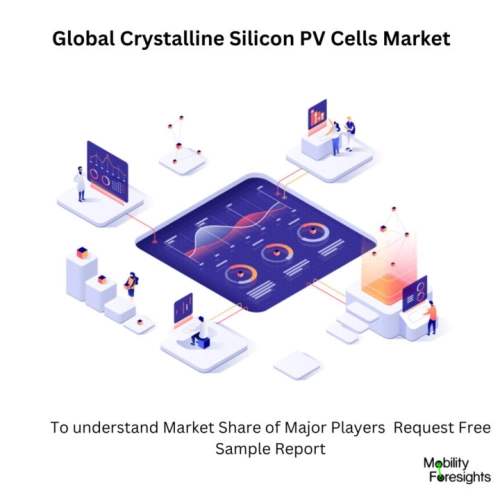
- Get in Touch with Us

Last Updated: Apr 25, 2025 | Study Period: 2024-2030
Crystalline silicon (c-Si) photovoltaic (PV) cells are a type of solar cell that convert sunlight directly into electricity. They are the most common type of solar cell and make up around 90% of the solar cells used in the world today.
C-Si PV cells are made from semiconductor materials, typically silicon, and have a structure similar to an electronic diode. When sunlight shines on the cell, it generates an electric field across the P-N junction, which causes electrons to flow, generating electricity.
C-Si PV cells have many advantages, including high efficiency, long lifespans, and low cost. They also require minimal maintenance, making them an ideal choice for residential and commercial solar applications. Additionally, their performance is relatively unaffected by temperature, meaning they perform well in both warm and cold climates.
C-Si PV cells come in a variety of shapes, sizes, and efficiencies, making them highly customizable. They are also available in both monocrystalline and polycrystalline forms. Monocrystalline cells are made from a single silicon crystal and offer higher efficiency than polycrystalline cells, though they are also more expensive.
C-Si PV cells are a reliable and cost-effective way to generate electricity from the sun. They are highly efficient, require minimal maintenance, and can be customized to meet a variety of energy needs and budgets. With their many advantages, they are likely to remain the leading type of solar cell for years to come.

The Global Crystalline silicon PV cells market accounted for $XX Billion in 2023 and is anticipated to reach $XX Billion by 2030, registering a CAGR of XX% from 2024 to 2030.
The lightweight, curved crystalline silicon (c-Si) solar modules developed by Japan's National Institute of Advanced Industrial Science and Technology (AIST) include a polyethylene terephthalate (PET) front cover rather from a traditional glass one.
They have shown that, in high-temperature and high-humidity environments, crystalline silicon solar cell modules with a PET film cover exhibit exceptional reliability.
They believe that the weight decrease will probably result in lower transportation and installation costs, however they haven't analysed the system cost yet. Development of lightweight and flexible crystalline silicon solar cell modules with PET film cover for high reliability in high temperature and humidity conditions." PET films are a good substitute for glass covers because of their improved electrical insulation.
However, it was also determined that the PET-based module has a 10% lower current value because PET film includes an anti-reflectance structure, whilst glass does not. It was discovered that the voltage and fill factor values were nearly identical to those of the benchmark glass module.
"The fabricated modules exhibit flexibility due to the lack of a glass cover. Additionally, upon placing and removing the modules from a measurement stage with a 200 mm radius of curvature, no defects or cracks were detected." Additionally, they put the modules through a battery of damp heat (DH) tests at 85 degrees Celsius and with 85% relative humidity.
What they discovered was that the glass-based panel's fill factor and current values degraded after 3000 h because of corrosion of the silver (Ag) front electrodes.The modules were constructed by the scientists using c-Si polycrystalline aluminium back surface field (Al-BSF) structured solar cells measuring 156 mm2 à 156 mm2 and having a thickness of roughly 250 μm.
The four-cell modules' strings were soldered in series by hand, and the strings at the busbar were joined by machine soldering. The front cover and backsheet of the module were made of 0.025 mm-thick PET film, and the panels were enclosed with ethyl vinyl acetate (EVA).
The module structure was either Backsheet or PET/EVA/c-Si cell/EVA/PET.The researchers observed that the novel module was more flexible than the reference panel made of glass with a thickness of 3.2 mm when comparing the thermal behaviour of the two samples.
| Sl no | Topic |
| 1 | Market Segmentation |
| 2 | Scope of the report |
| 3 | Abbreviations |
| 4 | Research Methodology |
| 5 | Executive Summary |
| 6 | Introdauction |
| 7 | Insights from Industry stakeholders |
| 8 | Cost breakdown of Product by sub-components and average profit margin |
| 9 | Disruptive innovation in theIndustry |
| 10 | Technology trends in the Industry |
| 11 | Consumer trends in the industry |
| 12 | Recent Production Milestones |
| 13 | Component Manufacturing in US, EU and China |
| 14 | COVID-19 impact on overall market |
| 15 | COVID-19 impact on Production of components |
| 16 | COVID-19 impact on Point of sale |
| 17 | Market Segmentation, Dynamics and Forecast by Geography, 2024-2030 |
| 18 | Market Segmentation, Dynamics and Forecast by Product Type, 2024-2030 |
| 19 | Market Segmentation, Dynamics and Forecast by Application, 2024-2030 |
| 20 | Market Segmentation, Dynamics and Forecast by End use, 2024-2030 |
| 21 | Product installation rate by OEM, 2023 |
| 22 | Incline/Decline in Average B-2-B selling price in past 5 years |
| 23 | Competition from substitute products |
| 24 | Gross margin and average profitability of suppliers |
| 25 | New product development in past 12 months |
| 26 | M&A in past 12 months |
| 27 | Growth strategy of leading players |
| 28 | Market share of vendors, 2023 |
| 29 | Company Profiles |
| 30 | Unmet needs and opportunity for new suppliers |
| 31 | Conclusion |
| 32 | Appendix |